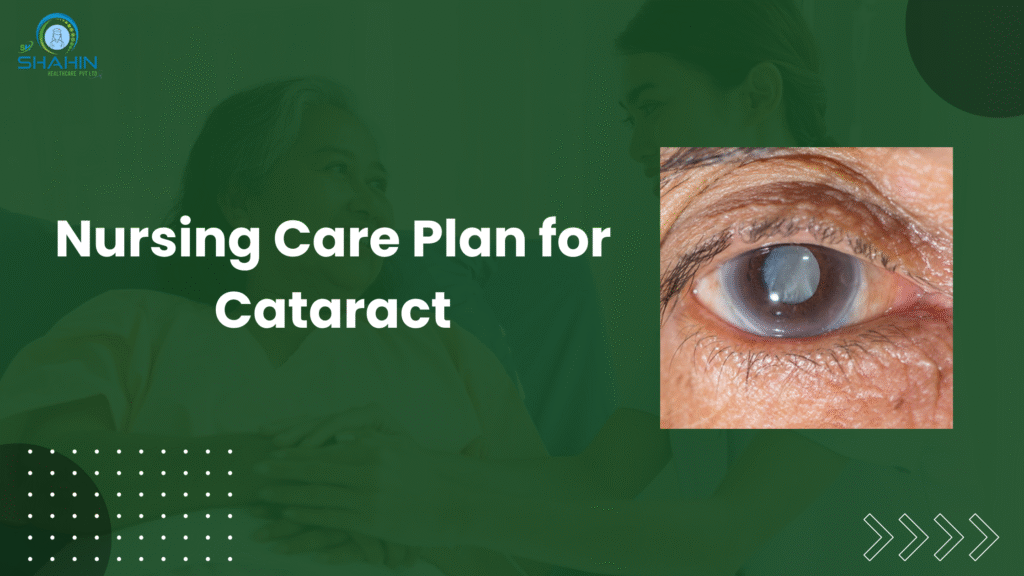Cataracts are a leading cause of visual impairment, especially among aging populations. Their gradual onset can challenge daily life, but with a detailed cataract care plan and individualized nursing diagnosis for cataract, patients can regain independence and maintain a high quality of life.
This comprehensive blog dives deeply into all facets of cataract care: from understanding the condition and its diagnosis, to formulating and executing a robust nursing care plan, post-operative support, and how modern home care services empower recovery.
What is a Cataract?
A cataract is a clouding of the eye’s natural lens, which sits behind the iris and pupil. Normally, the lens focuses light precisely onto the retina, giving sharp images. Over time, with age or risk factors, proteins in the lens clump together, creating opaque patches.
This opacity distorts and dims vision, making everyday activities like reading, driving, or recognizing faces challenging. The condition progresses slowly, giving people time to adjust, but also making early recognition and intervention crucial. Effective nursing care hinges on understanding how cataracts evolve and how they disrupt life.
Impact on Daily Life
The blurry vision from cataracts is more than a nuisance—it can make night driving dangerous due to glare, dull once-vivid colors, and cause people to misjudge steps or miss obstacles, increasing fall risk. If left unmanaged, cataracts may eventually cause significant vision loss.
Symptoms of Cataract
Cataracts often develop without pain, redness, or other immediate symptoms, so subtle signs must be monitored closely during regular nursing assessments:
-
Blurry or cloudy vision: Seeing through a cataract is akin to peering through frosted glass. Vision loses its crispness, especially in dim light.
-
Increased glare and sensitivity to bright lights: Glare from headlights or sunlight often becomes overwhelming, necessitating squinting or avoidance.
-
Halos around lights: Patients frequently report halos or auras, especially at night.
-
Fading or yellowing of colors: Colors may seem dull and less vibrant.
-
Frequently changing prescriptions: Vision can worsen in fits and starts, leading to constant adjustments in eyeglasses.
By attuning to these symptoms, nurses can initiate timely referrals and interventions, forming the bedrock of a proactive cataract care plan.
Causes of Cataract
Understanding why cataracts form allows nurses to educate and empower patients on prevention and risk management:
-
Aging: Most cataracts are age-related. After age 40, natural changes in lens proteins begin.
-
Genetics: Some people are born with congenital cataracts or develop them in childhood.
-
Trauma: Eye injuries can disrupt lens clarity, inducing early cataracts.
-
Medical conditions: Diseases like diabetes rapidly accelerate cataract formation.
-
Medications: Long-term corticosteroid use is linked to increased cataract risk.
-
Lifestyle and environment: Smoking, excessive drinking, and prolonged UV exposure hasten cataract development.
Prevention and early intervention focus on modifying these factors, when possible, and tailoring educational components of the cataract nursing care plan accordingly.
Types of Cataract
A. Nuclear Cataracts
These affect the lens center, initially improving near vision (a phenomenon called “second sight”) but gradually yellowing and clouding vision. Over time, distinguishing colors—especially blues and purples—becomes harder.
B. Cortical Cataracts
Appearing as wedge-like, whitish streaks, these start at the lens’s outer edges (cortex) and move inward. They scatter light, causing glare and problems with contrast and depth perception.
C. Posterior Subcapsular Cataracts
Forming at the back of the lens, these rapidly impair reading and vision in bright light. Sufferers often report more pronounced glare and difficulty reading.
D. Congenital Cataracts
These develop in utero or early childhood, often due to genetic factors, infections during pregnancy, or metabolic diseases. They’re typically detected in routine checks and treated early to avoid lifelong vision issues.
Each type informs the nursing diagnosis for cataract and customizes care, whether that means enhancing contrast in a home environment or providing magnification tools.
Diagnosing Cataracts
A. Medical History and Symptom Review
Nurses gather detailed histories, noting vision changes, risk factors, and daily challenges. Early suspicion guides referrals for ophthalmic assessment.
B. Visual Acuity Test
Using a standard eye chart, each eye is tested for its ability to read letters at distance. Diminished acuity (not corrected by glasses) is a classic sign.
C. Slit-Lamp Examination
A specialized microscope illuminates and magnifies the front structures of the eye, revealing the location and extent of any cloudiness.
D. Retinal Examination
Under pupil dilation, the retina and lens are inspected for any abnormalities. Nurses prepare patients for these drops (which can blur vision for a few hours) and answer pre-test questions, reducing anxiety.
Nurses play a pivotal role in nursing diagnosis of cataract by monitoring vision status, preparing patients for tests, and interpreting findings.
Treatment of Cataracts
A. Conservative Management
Early on, vision aids (brighter lights, magnifiers) and updated prescriptions may suffice.
B. Surgery
When vision impairs daily life, cataract surgery—removing and replacing the clouded lens with a clear intraocular lens (IOL)—is the gold standard. It’s safe, often completed in under an hour, and boasts high success rates.
-
Timing: Surgery is elective and depends on personal and professional needs.
-
Special considerations: Diabetics and those with other eye conditions may need closer follow-up.
Nurses are crucial at each phase—educating, supporting decision-making, and preparing patients and families for surgery and recovery.
Prevention Measures
While not all cataracts can be prevented, risk reduction is possible:
-
Nutrition: Diets rich in antioxidants (vitamins C/E), leafy greens, and colorful fruits may slow lens damage.
-
Smoking cessation: Tobacco puts individuals at higher risk; nurses can guide counseling and support.
-
Sun protection: Regular sunglasses or a wide-brimmed hat shield eyes from harmful UV radiation.
-
Diabetes management: Sharply controlling blood sugar levels is vital for diabetics to delay cataract onset.
-
Regular eye exams: Early detection identifies issues even before noticeable symptoms.
Nurses champion lifestyle changes as part of a holistic cataract nursing care plan, maximizing intervention success.
Comprehensive Nursing Care Plan for Cataract
Developing and implementing an effective nursing diagnosis for cataract hinges on recognizing both physical and psychosocial challenges:
Assessment
-
Vision testing: Regular, document changes in acuity.
-
Functional status: Can the patient dress, bathe, cook safely?
-
Home safety: Evaluate for tripping hazards, poor lighting, or obstacles.
-
Emotional state: Check for anxiety, withdrawal, or depression related to vision loss.
Common Nursing Diagnoses
-
Disturbed sensory perception (visual): Patient is unable to see clearly, making navigation and ADLs difficult.
-
Risk for injury: Vision deficits increase likelihood of falls or accidents.
-
Self-care deficit: Trouble with hygiene, meals, or medication due to sight limitation.
-
Anxiety: Worry about surgery or possible permanent vision loss.
-
Deficient knowledge: Unaware of procedures or potential for recovery.
Goals and Outcomes
-
Patient maintains safety, avoids falls or injury.
-
Patient can describe their condition and care requirements.
-
Patient demonstrates improved or stabilized self-care abilities.
-
Anxiety and fear are reduced with education and support.
Nursing Interventions
-
Safety adaptations: Remove rugs, provide nightlights, mark steps, ensure adequate lighting in all rooms, especially bathrooms and hallways.
-
Assistive devices: Recommend magnifying glasses, prescription lenses, or speech-reading devices as indicated.
-
Medication management: Teach proper use of prescribed eye drops or oral medications.
-
Emotional support: Provide a platform for sharing fears, clarify surgical benefits/risks, and offer reassurance throughout treatment.
-
Encourage independence: Facilitate strategies for self-care; involve occupational therapy if needed.
Post-Operative Nursing Care
-
Eye Protection
-
Encourage use of eye shields or sunglasses, especially outdoors or during sleep for the first few days post-op.
-
-
Activity Modification
-
Advise avoidance of bending, heavy lifting, or activities that sharply raise intraocular pressure.
-
Instruct patients on safe movements and posture.
-
-
Medication and Wound Care
-
Strictly adhere to prescribed antibiotic or anti-inflammatory eye drops to prevent infection.
-
Teach sterile drop instillation techniques.
-
-
Detecting Complications
-
Report increased pain, redness, swelling, loss of vision, or discharge—a sign of infection or retinal detachment.
-
-
Hygiene and Infection Control
-
Wash hands before touching the eye.
-
Educate on avoiding tap water exposure, especially during showers or washing the face.
-
-
Functional Recovery
-
Gradually reintroduce daily activities, starting with light tasks.
-
Avoid strenuous activities until cleared by the ophthalmologist.
-
-
Promote Follow-Up
-
Reinforce the importance of keeping all scheduled post-op appointments. Nurses often help arrange transportation or reminders.
-
Emotional and Social Support
Vision changes take a psychological toll. Fear, dependence, or frustration are common. Family involvement and social support are key:
-
Encourage communication: Let patients express their worries and hopes.
-
Family education: Teach family how to best assist while fostering independence.
-
Community resources: Suggest low-vision support groups or local agencies.
A robust cataract care plan goes beyond the eye—it supports the whole patient.
Role of Home Nursing Services
Home-based care ensures seamless recovery and support, particularly for elderly or mobility-limited patients.
Services Provided
-
Medication reminders: Nurses provide timely administration of eye drops and oral medications.
-
Personal care: Assistance with bathing, grooming, and dressing, minimizing fall risk.
-
Nutritional support: Meal planning and feeding assistance, especially if vision limits ability to prepare food.
-
Wound monitoring: Routine tracking for infection or slow healing, notifying providers as needed.
-
Rehabilitation: Encouraging gradual resumption of daily activities and exercises, as appropriate.
Home nurses offer both technical skills (medication administration, wound care) and compassionate support, easing the burden on families and reassuring patients.
[image:3]
FAQs
Q: What are examples of nursing diagnoses for cataract?
A: Disturbed sensory perception (visual), risk for injury, self-care deficit, anxiety, and deficient knowledge are standard diagnoses that guide interventions.
Q: How do I book a nurse for cataract post-op care?
A: Investigate local or online home nursing providers. Review credentials, read patient testimonials, and consult with your surgeon or ophthalmologist for reputable services. Many facilities also offer tailored aftercare programs coordinated with your eye doctor.
Conclusion
Cataracts need not spell the end of independence or visual enjoyment. Early recognition, individualized nursing diagnosis of cataract, and a stepwise cataract nursing care plan ensure safety, promote recovery, and empower both patients and caregivers.
Nurses stand at the heart of this process—from education and home safety to emotional reassurance and expert wound care. With comprehensive support, patients can look forward to clear vision and a return to valued daily activities.

